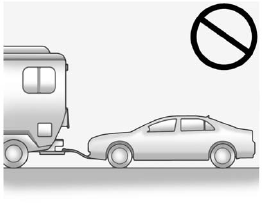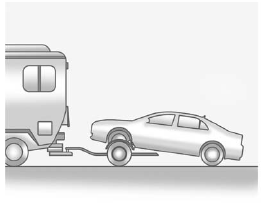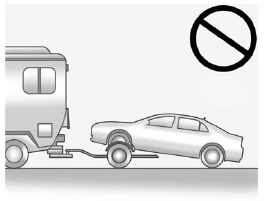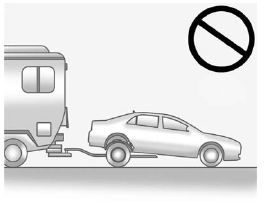Buick LaCrosse: Towing
 Buick LaCrosse: Towing
Buick LaCrosse: Towing
Towing the Vehicle
Notice:
To avoid damage, the
disabled vehicle should be towed
with all four wheels off the
ground. Care must be taken with
vehicles that have low ground
clearance and/or special
equipment. Always flatbed on a
car carrier.
Consult your dealer or a professional towing service if the disabled vehicle must be towed.
See Roadside Assistance Program (U.S. and Canada) or Roadside Assistance Program (Mexico).
To tow the vehicle behind another vehicle for recreational purposes, such as behind a motor home, see “Recreational Vehicle Towing” in this section.
Recreational Vehicle Towing
Recreational vehicle towing means towing the vehicle behind another vehicle such as a motor home. The two most common types of recreational vehicle towing are known as dinghy towing and dolly towing. Dinghy towing is towing the vehicle with all four wheels on the ground. Dolly towing is towing the vehicle with two wheels on the ground and two wheels up on a device known as a dolly.
Here are some important things to consider before recreational vehicle towing:
• What is the towing capacity of the towing vehicle? Be sure to read the tow vehicle manufacturer's recommendations.
• What is the distance that will be traveled? Some vehicles have restrictions on how far and how long they can tow.
• Is the proper towing equipment going to be used? See your dealer or trailering professional for additional advice and equipment recommendations.
• Is the vehicle ready to be towed? Just as preparing the vehicle for a long trip, make sure the vehicle is prepared to be towed.
Dinghy Towing

Dinghy Towing
Notice:
If the vehicle is towed
with all four wheels on the
ground, the drivetrain
components could be damaged.
The repairs would not be covered
by the vehicle warranty. Do not
tow the vehicle with all four
wheels on the ground.
The vehicle was not designed to be towed with all four wheels on the ground. If the vehicle must be towed, a dolly should be used. See “Dolly Towing” that follows for more information.
Dolly Towing from the Front (Front-Wheel Drive)

Dolly Towing from the Front
(Front-Wheel Drive)
Vehicles with front-wheel drive can be dolly towed from the front.
Use the following procedure to dolly tow the vehicle from the front:
1. Attach the dolly to the tow vehicle following the dolly manufacturer's instructions.
2. Drive the front wheels onto the dolly.
3. Shift the transmission to P (Park).
4. Firmly set the parking brake.
5. Use an adequate clamping device designed for towing to ensure that the front wheels are locked into the straight-ahead position.
6. Secure the vehicle to the dolly following the manufacturer's instructions.
7. Release the parking brake only after the vehicle being towed is firmly attached to the towing vehicle.
8. Turn the ignition to LOCK/OFF.
Dolly Towing from the Front (All-Wheel Drive)

Dolly Towing from the Front
(All-Wheel Drive)
Vehicles with all-wheel drive cannot be dolly towed.
Dolly Towing from the Rear

Dolly Towing from the Rear
The vehicle cannot be dolly towed from the rear.


